Keep on Smiling
Replacing a full set of teeth could be a tricky affair. Important questions need answering. Firstly, what are the patient’s main wishes and why does the patient wish to undergo this treatment?
Reasons for replacing one’s dentition
- Current teeth have persistent abscesses. Teeth have already undergone extensive work including root canal treatment and now require extraction
- Remaining teeth are mobile due to gum disease and cause discomfort on eating
- Unstable denture on eating and talking
- Pyscologically traumatic due to long-standing edentulism (lack of teeth)
- Lifelong dream of having a perfect smile
Generally speaking in the upper or lower jaw, 6implants are required to replace 12-14 teeth. Having said that four implants may at times be used to replace 12teeth while eight implants would definitely guarantee fourteen teeth (normal number of teeth in each jaw). The conventional method for placing implants is changing to a more advanced computer-aided technique. Using this technology CT scans are taken and the information downloaded onto an implant-planning programme. The information may be used to fabricate a surgical guide to the exact pre-planned implant placement requirements eliminating the need for any gingival incisions and suturing. This offers maximum comfort with no swelling or discomfort enabling the patient to return to his or her daily routine.
If the volume of bone present is not sufficient then bone-grafting procedures may have to be undertaken. In the upper jaw the maxillary sinuses are partly filled with bone grafting material. In this manner the implants are completely surrounded by bone achieving excellent stability and allow for full osseo-integration(fusion to bone).
In most cases the implants are placed at the same time as the bone graft is done. This avoids a second surgical sitting and halves the treatment time. In the lower jaw, bone grafting is rarely required. This is also thanks to the computer-aided implant planning technique, which allows for more precise implant placement by avoiding important anatomical structures. Using this technique implants are angulated allowing for an increase in the span and number of teeth as well as reduces the overall number of implants required.
Once the implants are inserted in either of the jaws, 4-6 months is required for complete healing. During this time a removable denture may be used to replace the teeth. In a number of cases temporary teeth may be fixed to the implants on the same day as they are inserted in the jaw offering the patient a fixed provisional dentition. These temporary teeth would be constructed of strong resin and offer good aesthetics. This form of temporarisation is determined by the number of implants used as well as the quantity and quality of bone. After 4-6months of complete healing the temporary fixed teeth are removed, an impression is taken and the permanent fixed prosthesis is planned. At this stage the patient’s input is of paramount importance. The type of material used for the permanent fixed teeth may vary from a semi-precious metallic substructure to a metal-free zirconium substructure. The substructure is then coated with resin or porcelain teeth. Colour, shape and size are required to fulfill the patient’s desired look. The set-up of the new teeth is tried in place and shown to the patient. This try-in stage allows for a few final adjustments before completion and fixation onto the implants.
Once the final set of teeth is fixed onto the implants the patient realises the importance of all the clinical time required to plan and execute the job. The hefty price tag is secondary to the irreplaceable comfort achieved!


